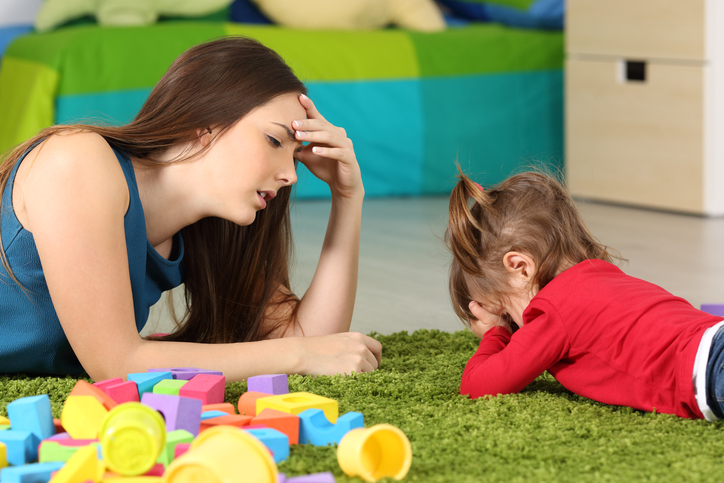What mom hasn’t approached the check-out line in a grocery store with dread? You just know your child is going to start whining for every candy bar, toy, game, and other shiny thing they see between you and the exit.
Then, when you say no, they might whine and drag their feet about leaving the store without whatever it was they so desperately wanted.
Meanwhile, your nerves are getting more frazzled by the minute.
Wondering how to stop whining kids without losing your mind? We’re right there with you.
Parenting pros say it’s important to stay calm and not over-react. Easier said than done.
But your whining child is seeking attention, so a reaction will only reinforce the behavior.
Instead, try to find a way to reconnect with your child without reacting. Stumped on how to do that? Don’t worry, we’ll explain below.
So what’s the real trick for how to stop whining? Follow our five step process, don’t give in, and be consistent!
What Causes Whining?
Oh yes, the dreaded whining phase. Is there anything more frustrating then the sound of a shrill pleading voice begging for a toy or treat?!
That was a rhetorical question.
The sound of a whiny toddler gets on the nerves of parents everywhere.
But before you give in, give up, or yell back in anger…remember that whining is important communication. And it has nothing to do with whatever your child is whining about.
What a whining child is really saying is “I feel powerless! I feel alone! I want attention!”
To stop a child from whining, you first need to understand where the behavior comes from.
Toddler whining happens when a child’s sense of connection to a parent or caregiver is broken.
Kids need adults to provide pretty much everything for them. Whining is a way for young kids who don’t have the vocabulary to express their feelings, to get your attention.
RELATED: How To Handle Temper Tantrums In Toddlers
A whiny child wants a response from you, be it positive or negative. And we know whining is hard to ignore, so this tactic works!
But here’s the thing, if you want to stop kids from whining, then you need to buckle up and NOT react.
A whining child is looking for a reaction, ANY reaction, so if you yell, try to “reason” with them, or give in to their demands…you’re only reinforcing the whining behavior.

How To Stop Whining Kids
1. Stay Calm
Make the decision now that you won’t lose it the next time your child starts whining.
Practice your parent poker face. Go ahead, we’ll wait.
You got it? Good!
That’s the first step for how to stop whining. Because if your kids get a reaction out of you, they’ll think whining works!
And then they’ll be more likely to use that behavior as an attention-getting tactic in the future.
Plus, as you probably know from past experience, yelling doesn’t work on a whining child.
2. Define The Whining Problem
Make sure your child understands the difference between whining and asking nicely. You might assume they know this, but many young children do not.
Point out their whining voice when you hear it and ask your child to use their regular voice instead.
Sometimes it’s helpful to record a child when they are whining and speaking normally.
Then, at a time when your child is relaxed and receptive, play them both versions and talk about the difference.
This way when you tell a whining child to “ask nicely” you can be sure they understand what you’re talking about.
RELATED: Toddler Terrible Twos: My Child Says No All The Time
3. Acknowledge Your Child
Remember, your child feels disconnected from you in this moment. Acknowledge their need for attention with eye contact, a hand on the shoulder, something to let them know you’re there, but without giving in to their demands.
Whining children have pent up feelings. You want them to know you’ll be with them through this rough moment, but you’re not giving in.
Your child may stop whining at this point and just cry, which is okay.
They are releasing their frustration – let them.
RELATED: Positive Phrases To Say Instead Of “Stop Crying!”
4. Ask for Their Regular Voice
The next step for how to stop whining is to let your child know you’ll listen to them ONLY when they use their regular voice. You can tell your child:
“I can’t understand you when you talk like that, use your regular voice and I will be happy to listen.”
Praise your child if and when they switch over to their normal voice. “Thanks for asking so nicely” or “my ears love that voice”.
The positive attention will encourage a whining child to switch over to their normal voice more quickly in the future.
5. Be Consistent
Our biggest tip for how to stop whining kids? Don’t give in one day and then expect your whining child to use their regular voice the next.
Keep telling them you will only listen when they use their normal voice, and praise them immediately when they do.
It won’t happen overnight, but once a child realizes they can’t get the attention they crave by whining, they’ll eventually abandon that behavior.
Lastly, hang in there! When your child is whining he/she isn’t out to get you (though it may feel like that in the moment).
Your little one just needs an emotional outlet for their feelings of powerlessness.
Once they regain a feeling of connection with you, your whiny child will be able to pull themselves together and stop using the “poor me” voice.
That’s how to stop whining, once and for all.
Also In Beenke: Are You Raising Impatient Entitled Kids?
SHARE how to stop whining on Facebook and Pinterest by clicking the buttons below.












